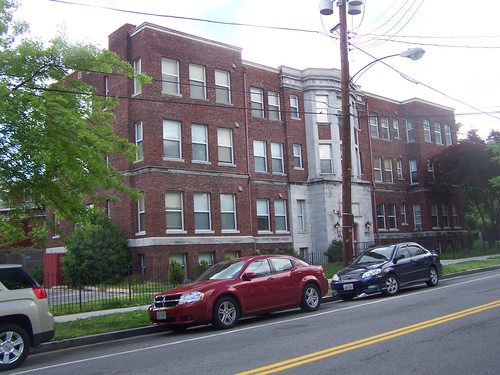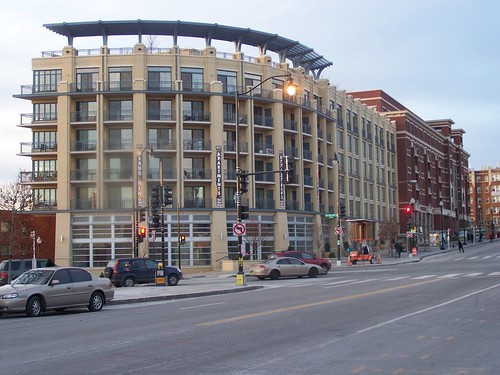Transit and parking? How about transit and density as a priority?
 Right: a three story apartment building on Colorado Avenue NW, a couple blocks from the old 50s streetcar station at 14th Street.
Right: a three story apartment building on Colorado Avenue NW, a couple blocks from the old 50s streetcar station at 14th Street.I have written about transit oriented development in many many posts.
The basic point is that it is nothing new. 1920s and 1930s era 5 story apartment buildings along streetcar routes in otherwise single family housing districts is an example of TOD.
Communities like Shaker Heights in Cleveland and Forest Hills in Queens are prominent examples. But there are literally thousands of examples across the United States.
Around 11 years ago, DC's Office of Planning published a manual on the topic, Trans-Formation: Recreating Transit-Oriented Neighborhood Centers in DC: Design Handbook.
And more recently University of British Columbia professor Patrick Condon wrote a book touting streetcar-related neighborhood revitalization (along with creating an interconnected street system), Seven Rules for Sustainable Communities: Design Strategies for the Post Carbon World, published by Island Press.
The book is also summarized in a series of pieces in The Tyee, Vancouver's alternative weekly. See "Why a Streetcar Is Something to Be Desired: Rule 1 for sustainable communities: Restore the streetcar city."
Anyway, for all of the discussion lately, in this blog and elsewhere, about why it is reasonable to lower parking requirements for newly constructed multiunit housing buildings located in high-walking areas that are well-served by transit, what we haven't been discussing is the need to add a bit of density to what is currently being built?
It reminds me of a conversation I had with the Baltimore County lead transportation planner. We were lamenting how the Baltimore subway needs to be extended to the White Marsh section of Baltimore County, but previous downzoning initiatives for Eastern Baltimore County limited the financial payoff from transit proximity and therefore the likelihood of extension was significantly lowered.
The first 25 years of transit-related development in DC was focused on the core of the city--the central business district--which has expanded outward from Downtown and so it touches some of the city's neighborhoods around the core, like Capitol Hill or Dupont Circle.
 Right: the Park Place Apartment building on Georgia and New Hampshire Avenues NW was constructed over the top of the west side exit of the Metro Station.
Right: the Park Place Apartment building on Georgia and New Hampshire Avenues NW was constructed over the top of the west side exit of the Metro Station.It has only been the last 8 years or so that transit-oriented development has moved out of the core to neighborhoods like Tenleytown, Columbia Heights, Petworth, and Fort Totten.
Not all of this development, particularly at Rhode Island and Fort Totten stations, has adequately leveraged the proximity to transit.
In short, the buildings are too short, or at least, don't fully take advantage of transit proximity. And by not being denser, the ability of these developments to generate retail and other neighborhood improvements is somewhat impinged.
Basically, a lot of the buildings are four-stories, when they should probably be at least six-stories. It is the 21st century after all.
The recommendation would be that there should be a 20% density bonus in zoning (triggering community benefits) for development projects at transit stations and at nodes in certain transit corridors.
Left: four-story apartments constructed in the former parking lot abutting the Rhode Island Metro Station.
Labels: real estate development, transit and economic development, transit oriented development, urban design/placemaking





0 Comments:
Post a Comment
<< Home